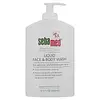What's inside
What's inside
 Key Ingredients
Key Ingredients

No key ingredients
 Benefits
Benefits

 Concerns
Concerns

 Ingredients Side-by-side
Ingredients Side-by-side

Water
Skin ConditioningSodium C14-16 Olefin Sulfonate
CleansingSodium Laureth Sulfate
CleansingDisodium Laureth Sulfosuccinate
CleansingSodium Chloride
MaskingLaureth-2
CleansingPanthenol
Skin ConditioningGlycol Distearate
EmollientParfum
MaskingSaccharide Isomerate
HumectantAllantoin
Skin ConditioningNiacinamide
SmoothingPyridoxine Hcl
Skin ConditioningGlycine
BufferingMagnesium Aspartate
Skin ConditioningAlanine
MaskingLysine
Skin ConditioningLeucine
Skin ConditioningBiotin
AntiseborrhoeicGlycerin
HumectantSodium Lauroyl Glutamate
Sodium Citrate
BufferingCocamidopropyl Betaine
CleansingSorbitan Laurate
EmulsifyingPEG-120 Methyl Glucose Dioleate
EmulsifyingPhenoxyethanol
PreservativePotassium Sorbate
PreservativeSodium Benzoate
MaskingCI 47005
Cosmetic ColorantCI 42090
Cosmetic ColorantWater, Sodium C14-16 Olefin Sulfonate, Sodium Laureth Sulfate, Disodium Laureth Sulfosuccinate, Sodium Chloride, Laureth-2, Panthenol, Glycol Distearate, Parfum, Saccharide Isomerate, Allantoin, Niacinamide, Pyridoxine Hcl, Glycine, Magnesium Aspartate, Alanine, Lysine, Leucine, Biotin, Glycerin, Sodium Lauroyl Glutamate, Sodium Citrate, Cocamidopropyl Betaine, Sorbitan Laurate, PEG-120 Methyl Glucose Dioleate, Phenoxyethanol, Potassium Sorbate, Sodium Benzoate, CI 47005, CI 42090
Water
Skin ConditioningAcrylates Copolymer
Sodium Lauroyl Sarcosinate
CleansingCoco-Glucoside
CleansingCocamidopropyl Betaine
CleansingTriethanolamine
BufferingSalicylic Acid
MaskingErythritol
HumectantPhenoxyethanol
PreservativeEthylhexylglycerin
Skin ConditioningSaccharide Isomerate
HumectantCitric Acid
BufferingChamomilla Vulgaris Extract
Skin ProtectingSodium Citrate
BufferingSodium Edtmp
CI 42090
Cosmetic ColorantIngredients Explained
These ingredients are found in both products.
Ingredients higher up in an ingredient list are typically present in a larger amount.
Ci 42090 is a synthetic dye created from petroleum. It is used to give a bright blue color to cosmetics, medicine, and food.
Cocamidopropyl Betaine is a fatty acid created by mixing similar compounds in coconut oil and dimethylaminopropylamine, a compound with two amino groups.
This ingredient is a surfactant and cleanser. It helps gather the dirt, pollutants, and other impurities in your skin to be washed away. It also helps thicken a product and make the texture more creamy.
Being created from coconut oil means Cocamidopropyl Betaine is hydrating for the skin.
While Cocamidopropyl Betaine was believed to be an allergen, a study from 2012 disproved this. It found two compounds in unpure Cocamidopropyl Betaine to be the irritants: aminoamide and 3-dimethylaminopropylamine. High-grade and pure Cocamidopropyl Betaine did not induce allergic reactions during this study.
Learn more about Cocamidopropyl BetainePhenoxyethanol is a preservative that has germicide, antimicrobial, and aromatic properties. Studies show that phenoxyethanol can prevent microbial growth. By itself, it has a scent that is similar to that of a rose.
It's often used in formulations along with Caprylyl Glycol to preserve the shelf life of products.
Saccharide Isomerate comes from sugars found in corn. It is a skin hydrator.
The structure of this ingredient can be altered to be more similar to the carbohydrates found in our skin. This ability to mimic our skin gives it hydrating properties.
Specifically, saccharide Isomerate is a humectant. Humectants draw moisture from the air to our skin.
Research shows Saccharide Isomerate to be an effective moisturizer.
Learn more about Saccharide IsomerateSodium Citrate is the sodium salts of citric acid. In skincare, it is used to alter pH levels and acts as a preservative.
Its main functions are to maintain the pH of a product and neutralize metal ions.
The acidity of our skin is maintained by our glands and skin biome; normal pH level of skin is slightly acidic (~4.75-5.5).
Being slightly acidic allows our skin to create an "acid mantle". This acid mantle is a thin barrier that protects our skin from bacteria and contaminants.
Learn more about Sodium CitrateWater. It's the most common cosmetic ingredient of all. You'll usually see it at the top of ingredient lists, meaning that it makes up the largest part of the product.
So why is it so popular? Water most often acts as a solvent - this means that it helps dissolve other ingredients into the formulation.
You'll also recognize water as that liquid we all need to stay alive. If you see this, drink a glass of water. Stay hydrated!
Learn more about Water